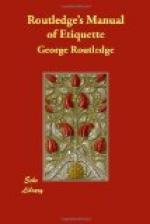[Illustration]
LEG OF MUTTON OR LAMB.
The best part of this joint is in the middle, between the knuckle and farther end, and the best way to carve it is to make a deep cut at 1, and continue to cut thin slices as far as 2, on each side of the first incision; but as more fat is usually required than lies with the slice, a small neat slice may be added from the broad end at 3. The cramp-bone may be extracted, if asked for, by cutting down at 4, and passing the knife under in a semicircle to 5. The delicate fine meat of the under side, which lies beneath the “Pope’s eye,” is sometimes demanded by epicures.
[Illustration]
SHOULDER OF MUTTON OR LAMB.
Make an incision at 1 down to the bone, which will then afford a deep gap, from which on each side you may help thin slices, adding a little fat from the outer edge marked 2. If the demands are more than can be supplied at the first opening, additional slices may be obtained by cutting down to the blade-bone, marked 3, on each side. Some of the party may prefer slices from the under side, the meat of which is juicy, though less fine in grain; these must be cut horizontally.
LOIN OF MUTTON.
A loin of mutton is always brought to table with the joints of the bones divided; it is therefore merely necessary to begin at the narrow end, and cut off one chop at a time, with a small portion of the kidney if required, or of the rich kidney fat.
NECK OF MUTTON.
The joints of a neck of mutton are always divided before cooking in the same way as those of the loin, and the carving is simple. It is only necessary to begin at the long bones, where the best meat lies, the scrag, as it is usually called, being coarse and gristly, and frequently taken off before the joint is dressed for the table.
LAMB.
Lamb is generally carved in the same way as mutton, but rather more sparingly, as there is less meat on the joint; but when sent to table in the quarter, as it commonly is when young, it must be cut up after its own fashion as follows.
FORE QUARTER OF LAMB.
[Illustration]
This consists of the shoulder, ribs, and brisket. The shoulder must first be raised from the rest by passing the knife under the knuckle in the direction of 1, 2, 3, leaving a good portion of meat adhering to the ribs. A slice of butter, seasoned with pepper and salt, is laid between them, and the juice of a lemon squeezed over the ribs. This must remain a minute, and the shoulder may then be removed to another dish, for the convenience of carving the rest. The ribs and brisket must then be divided in the line 3, 4, the ribs separated, and brisket cut into small divisions, giving each person the choice of a rib or piece of the brisket. The shoulder, if required, must be cut in the same way as a shoulder of mutton.




